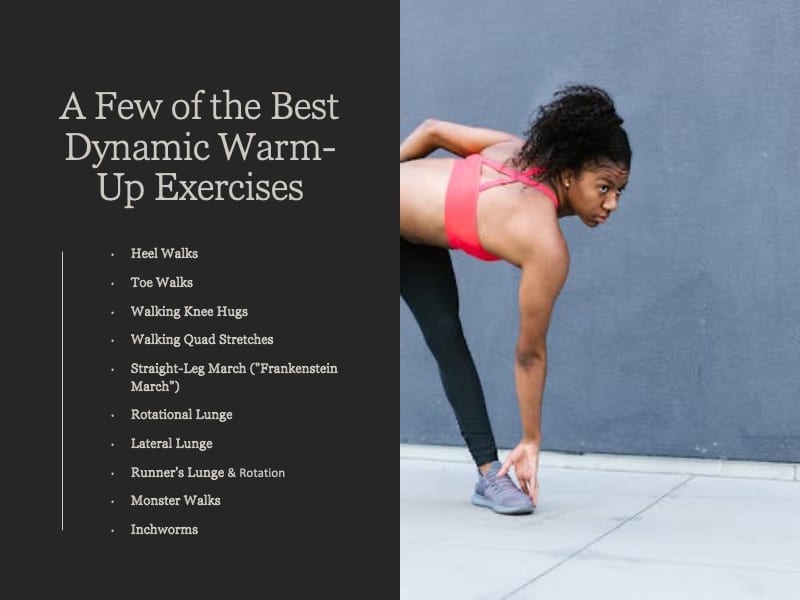Dynamic Warm-Up Guide & Best Dynamic Warm-Up Exercises
Like most people, I used to skip warm-ups entirely or just do a few static stretches before starting my workouts. Growing up, I was taught that stretching was the best way to prepare for exercise.
However, once I got to Marist College and began learning how strength and conditioning were done at the NCAA Division One level, I quickly realized the importance of a dynamic warm-up.
It became clear that this approach not only helps prevent injuries but also enhances performance and gets you more out of your workouts.
As I’ve grown older, my warm-ups have become even more comprehensive.
They now take longer because I understand that preparing the body for different movements is just as important as the main workout itself.
My dynamic warm-ups ensure that all my muscles and joints are ready to perform, and they also improve balance, stability, and proprioception, laying the foundation for a safe and effective workout.
What is a Dynamic Warm Up?
A dynamic warm-up is a series of controlled, active movements designed to prepare your body for physical activity by increasing your heart rate, enhancing joint mobility, and activating key muscle groups.
Unlike static stretching, which involves holding a stretch in one position, a dynamic warm-up incorporates continuous motion to mimic the movements required during your workout or sport.
Dynamic warm-ups improve blood flow, elevate muscle temperature, and prime your nervous system, helping your muscles and joints move more fluidly.
They also improve balance, coordination, and proprioception, making them an ideal way to reduce the risk of injury and optimize performance.
By progressively increasing intensity and targeting movement patterns similar to your workout, a dynamic warm-up bridges the gap between rest and full athletic performance.
Benefits of a Dynamic Warm-Up
A properly executed dynamic warm-up prepares your body for peak performance by:
- Increasing blood flow and oxygen delivery to muscles
- Activating key muscle groups to enhance stability and strength
- Improving joint mobility and range of motion
- Reducing the risk of injury during high-intensity activities
Why Dynamic Warm-Ups Are Better Than Static Stretching
Static stretching before a workout can temporarily reduce muscle responsiveness and hinder performance.
Research indicates that dynamic warm-ups improve agility, strength, and neuromuscular coordination, making them superior for pre-exercise preparation (Behm & Chaouachi, 2011).
Dynamic stretching and a proper dynamic warm-up also elevates body temperature, improve blood flow, and enhance range of motion, which reduces the likelihood of injury.
In contrast, static stretching is better suited for post-workout routines to improve flexibility and reduce muscle tension.
Dynamic warm-ups bridge the gap between resting and full athletic exertion by mimicking the movements required for your activity.
How to Do a Dynamic Warm-Up
An effective dynamic warm-up for your workouts progresses from general movements to sport-specific exercises.
Start with low-intensity movements that activate large muscle groups, then transition to drills that prepare your body for the specific challenges of your workout.
A well-rounded warm-up includes elements of mobility, muscle activation, and light plyometric exercises.
General Warm-Up Guidelines:
- Duration: 10-15 minutes
- Focus: Full-body activation, joint mobility, and progressive intensity
- Equipment: Mini-bands, mats (optional)
The Best Dynamic Warm-Up Exercises

Dynamic warm-ups are essential for preparing your body for exercise, and while this isn’t an exhaustive list, it includes many of my personal favorites.
These exercises have proven to be effective in enhancing mobility, stability, and strength while reducing the risk of injury.
Whether you’re an athlete or a fitness enthusiast, incorporating these movements can help you get the most out of your workouts.
1.) Heel Walks
Improves ankle stability and strengthens the tibialis anterior to reduce shin splints.
- How to Perform: Walk forward on your heels with toes pointed upward for 20 yards, keeping your chest upright and shoulders back.
2.) Toe Walks
Activates calf muscles and enhances ankle mobility.
- How to Perform: Walk forward on the balls of your feet with heels lifted for 20 yards, focusing on balance and control.
3.) Walking Knee Hugs
Stretches the glutes and hip flexors while improving balance.
- How to Perform: Pull one knee toward your chest while rising onto the opposite foot’s toes. Hold briefly before switching sides. Perform for 20 yards.
4.) Walking Quad Stretch
Enhances flexibility in the quadriceps and hip flexors.
- How to Perform: Grab your ankle behind you, pulling your heel toward your glutes, while reaching the opposite arm overhead. Perform for 20 yards.
5.) Straight-Leg March (“Frankenstein March”)
Stretches the hamstrings and improves dynamic flexibility.
- How to Perform: Swing one leg straight up while reaching the opposite hand toward your toes. Perform for 20 yards.
6.) Rotational Lunge
The rotational lunge is a forward lunge variation that also targets the hip flexors, obliques, and core muscles. If this exercise is too difficult, you can begin with a regular forward lunge until you master the basic movement.
- How to Perform: Step forward into a lunge and rotate your torso toward the lead leg. Alternate sides for 20 yards.
7.) Lateral Lunges
You can add several lunge variations to your dynamic warm-up, but lateral lunges are perfect as they improve hip mobility and activate the adductors and glutes.
- How to Perform: Step sideways into a deep lunge, keeping your chest upright and hips back. Alternate sides for 20 yards.
8.) Runner’s Lunge & Rotation
Opens up the hips and stretches the thoracic spine.
- How to Perform: Step into a deep lunge and place your hands on the ground inside your lead foot. Rotate your torso, reaching one arm toward the ceiling. Alternate sides for 20 yards.
9.) Monster Walks
Monster walks activate the glutes and outer thighs.
- How to Perform: With a mini-band around your knees, take small steps forward and backward while maintaining tension in the band. Perform for 20 steps in each direction.
10.) Inchworms
The inchworm exercise stretches the hamstrings and engages the core and shoulders.
- How to Perform: From a standing position, walk your hands forward into a plank, then walk your feet toward your hands. Repeat for 10-15 yards.
Advanced Dynamic Warm-Up Progressions
Once you master the basics, integrate light plyometric and sport-specific drills to elevate your warm-up:
1. Power Skips
Enhances explosive power and coordination.
- How to Perform: Skip forward while driving your knees and arms upward. Perform for 20 yards.
2. Lateral Bounds
Improves lateral stability and power.
- How to Perform: Jump side-to-side from one foot to the other, landing softly. Perform for 10 repetitions per side.
3. High Knees
Increases cardiovascular readiness and activates the hip flexors.
- How to Perform: Run in place, driving your knees toward your chest. Perform for 20 seconds.
4. Carioca (Grapevine)
Enhances hip mobility and coordination.
- How to Perform: Cross one leg in front of the other while moving laterally. Perform for 20 yards in each direction.
Final Thoughts: Are Dynamic Warm Ups the Best Way to Warm Up for Your Workouts?
A dynamic warm-up is undoubtedly one of the most effective ways to prepare your body for exercise, whether you’re gearing up for a high-intensity workout, a sprinting session, or high school sports.
These exercises not only enhance athletic performance but also reduce the risk of injury by improving flexibility, stability, and neuromuscular coordination.
If you’re looking to fine-tune your warm-up for sprinting, focus on exercises that activate the hips, hamstrings, and calves, ensuring your body is ready for explosive power.
If you are warming up for high school sports, incorporate movements that improve mobility and strength across multiple muscle groups to prepare for diverse demands.
By consistently integrating dynamic warm-ups into your routine, you’ll build a foundation for long-term health, better mobility, and peak athletic performance.
Customize your warm-up to suit your activity, and progress gradually to ensure your body is primed and ready for success.
This website does not provide medical advice. This website site does contain affiliate links, and purchases may earn a commission.
Read my Medical Disclaimer, Review Disclaimer, and Publishing Policies for more details. Use of this site indicates acceptance of these terms.



